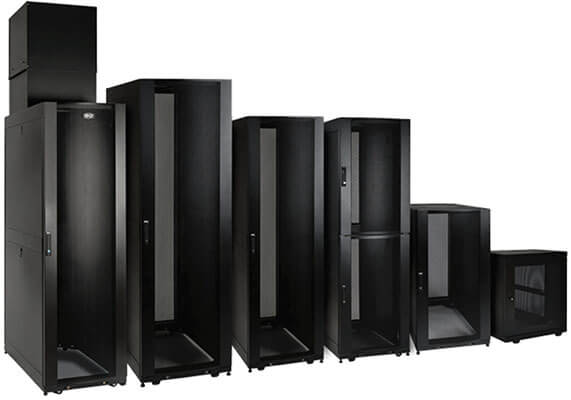Download document () of 20
Download
You have exceeded the download limit
Server Rack Buying Guide
Browse our top nine considerations to help you identify the most efficient option for your needs.
1. Invest in high-quality, long-life enclosures
Bottom line: Don’t skimp. Your rack will house critical gear and structured cabling for decades.
2. Always consider depth, width and height
Depth: Choose 1200 mm (47.24 in.) or greater to accommodate today’s deeper equipment and leave room for rear cable bends, airflow and accessories.
Width: Opt for 750 mm when you expect heavy cable volumes (200+ cables). The extra space on each side dramatically improves vertical cable routing and reduces congestion.
Height: Go as tall as fire codes allow (often 42U–48U). Taller cabinets maximize density without adding footprint, but you’ll need to ensure you have the required clearance (e.g., 18” from fire suppression heads).

3. Integrate cable management and analyze internal layout
Use integrated vertical cable managers to keep patching and power neat.
Route power and data cabling overhead when possible (especially in slab-floor designs) to keep the rear of racks free for airflow and maintenance.
Install stress-relief bars behind patch panels to protect terminations.
Consider double-sided vertical cable managers for large cross-connects.
4. Deciding between 4-post racks, 2-post racks or wall-mount enclosures
4-post racks:
2-post racks:
Best for lightweight gear such as patch panels, switches, or shallow network appliances.
Must be bolted down to prevent tipping.
Not ideal for heavier servers or UPS units due to lack of rear support.
Wall-mount enclosures
Designed for branch offices, retail sites, classrooms or closets where floor space is limited.
Secures gear above the floor to reduce exposure to accidents, dust and spills.
Available in swing-out designs for rear access and ventilated/fan-equipped models for thermal management.
Excellent for distributed IT/edge environments where a full rack footprint isn’t feasible but structured mounting and physical protection are still required.
Eaton’s Tripp Lite series wall-mount enclosures come in multiple sizes and NEMA/IP-rated options for industrial or harsh settings.
Summary
4-post = full-featured + heavy duty
2-post = economical + light duty
Wall-mount = space-saving + secure for edge
5. Deciding between open-frame and enclosed racks
Open-frame racks:
Excellent airflow, easy access, flexibility on depth.
Potential downsides: exposure to dust or accidental contact.
Best for locked or secure closets/workspaces.
Enclosed racks:
Provide physical security, containment against dust and possible noise reduction (especially with mesh or ventilated panels where airflow is required).
Adding fans at the top can help manage internal temperature.
Ideal for environments needing access control, noise control or additional protection.
6. UPS integration considerations
Space & weight: Rackmount UPSs are heavy; ensure the rack supports them. Bottom-mounting is preferred for stability.
Battery type: Lithium-ion UPS options reduce weight and extend lifespan — especially important in distributed IT environments.
Maintenance & access: Ensure enough clearance for replacing batteries or servicing UPS units inside the rack.
7. Rack PDU integration considerations
Mounting options: Vertical (0U) PDUs save rack space; horizontal PDUs work in shallow racks or wall-mounts.
If you are deploying vertical PDUs at the rear of your rack(s), verify that there’s space to mount them correctly and easily access them for as you update and replace equipment.
8. Remember cooling and airflow
Open racks rely on room cooling, while enclosed racks may need integrated fans or active cooling.
Fans and airflow accessories help manage hot spots in dense deployments.
Environmental sensors: Many Eaton PDUs support add-ons for temperature, humidity and door monitoring.
9. Prioritize security
Consider lockable doors, side panels and remote monitoring sensors.
For distributed IT applications, physical security is as important as cyber security.
Eaton as the benchmark
Eaton’s portfolio, including Tripp Lite series rack enclosures, offers a high-quality, versatile platform for Intermediate Distribution Frames (IDFs), Main Distribution Frames (MDFs), edge deployments and data centers.
They’re available in deep, wide and tall configurations to align perfectly with modern space, cabling and cooling requirements make them an ideal standard to design around.

